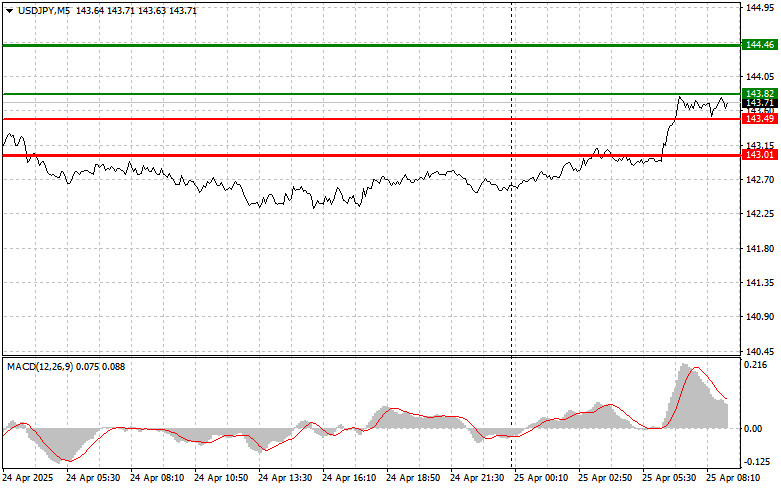Analysis of Trades and Trading Tips for the Japanese Yen
The price test at 142.60 happened when the MACD indicator had moved significantly above the zero mark, which I believe limited the pair's upward potential. For this reason, I did not buy the dollar and missed a fairly strong upward movement.
Despite positive reports from the U.S. labor market and encouraging data on durable goods orders, the U.S. dollar showed no significant strengthening against the yen during yesterday's session, although it more than made up for this during today's Asian session.
Traders ignored the rise in Tokyo's Core Consumer Price Index (excluding fresh food prices) and the increase in Japan's leading economic indicators, continuing to buy the dollar and sell the yen. This paradox, seemingly contrary to economic logic, reflects a deeper market understanding of the current macroeconomic environment and the outlook for monetary policy. Generally, such data—showing moderate inflation growth in Tokyo and positive signals from leading indicators—would typically be perceived as supportive for the national currency. However, amid global uncertainty due to trade tariffs and the lack of an agreement with Japan, these indicators lose their appeal. The market's disregard for local positive data suggests that global factors and expectations around future central bank decisions are dominating—and a new trade war could potentially influence the actions of the Japanese central bank as well.
For intraday strategy, I will focus primarily on implementing Scenarios #1 and #2.
Buy Signal
Scenario #1: I plan to buy USD/JPY today upon reaching the entry point at 143.82 (green line on the chart), with a target of rising to 144.46 (thicker green line). Around 144.46, I plan to exit long positions and open shorts in the opposite direction (aiming for a 30–35 pip reversal). It's best to return to buying this pair on corrections and significant pullbacks.
Important: Before buying, ensure that the MACD indicator is above the zero mark and just beginning to rise.
Scenario #2: I also plan to buy USD/JPY today in case of two consecutive tests of the 143.49 level when the MACD indicator is in the oversold zone. This will limit the pair's downside potential and trigger an upward market reversal. Growth toward the opposite levels at 143.82 and 144.46 can be expected.
Sell Signal
Scenario #1: I plan to sell USD/JPY today only after an update of the 143.49 level (red line on the chart), which should lead to a rapid decline. The key target for sellers will be the 143.01 level, where I plan to exit short positions and immediately open long positions in the opposite direction (aiming for a 20–25 pip reversal). Pressure on the pair could return at any moment.
Important: Before selling, ensure the MACD indicator is below the zero mark and starting to decline.
Scenario #2: I also plan to sell USD/JPY today in case of two consecutive tests of the 143.82 level when the MACD indicator is in the overbought zone. This will limit the pair's upside potential and trigger a downward market reversal. A decline toward the opposite levels at 143.49 and 143.01 can be expected.
What's on the Chart:
- The thin green line represents the entry price where the trading instrument can be bought.
- The thick green line indicates the expected price level where a Take Profit order can be placed, or profits can be manually secured, as further price growth above this level is unlikely.
- The thin red line represents the entry price where the trading instrument can be sold.
- The thick red line indicates the expected price level where a Take Profit order can be placed, or profits can be manually secured, as further price decline below this level is unlikely.
- The MACD indicator should be used to assess overbought and oversold zones when entering the market.
Important Notes:
- Beginner Forex traders should exercise extreme caution when making market entry decisions. It is advisable to stay out of the market before the release of important fundamental reports to avoid exposure to sharp price fluctuations. If you choose to trade during news releases, always use stop-loss orders to minimize potential losses. Trading without stop-loss orders can quickly wipe out your entire deposit, especially if you neglect money management principles and trade with high volumes.
- Remember, successful trading requires a well-defined trading plan, similar to the one outlined above. Making impulsive trading decisions based on the current market situation is a losing strategy for intraday traders.














